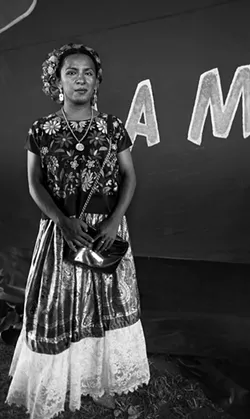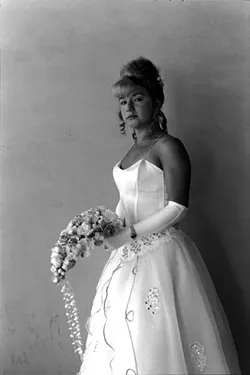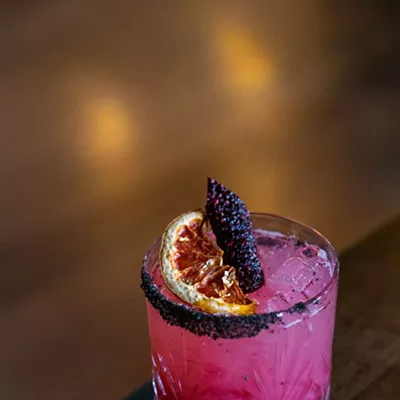Vittorio D’Onofri has been snapping photos of muxes — those who were registered as male at birth but identify as female or neither male nor female — for more than 20 years. What separates the Italian native, who lives in Oaxaca, Mexico, from many of his peers is that D’Onofri’s work is not sensational.
“I believe that it is the only way to have a total and unconditional inclusion of what the majority defines as different,” D'Onofri said while calling from Oaxaca.
“For me, there is no difference in feeling belonging to another gender or having sex with one’s own sex. In my photographs of muxe, I have intentionally photographed everyday life, without falling into glamour, eros or sex, precisely to highlight the equality of all of us in the daily moments that reflect our equality.”
D'Onfri, who is part of the “IAM: Muxes, S/He, Him, Family,” which runs Thursday, Nov. 14, to Friday, Jan. 10, at the Louis Carlos Bernal Gallery, Center for the Arts, longs for the normalization of the trans world.
“I would like a world where the word ‘different’ did not exist because it creates distance and barriers,” D’Onofri said.
“A world where we all feel equal is perhaps a utopia but I would like to live in a world like that.”
Exhibits like “I/Am: Muxes, S/He, Him, Family” help the cause, according to D’Onfri.
“This is my first time in Tucson and I don't know anything about the local trans world,” D’Onofri said.
“Thanks also to the support of the University (Pima Community College), I will be present at the inauguration, and this makes me very happy. A friend of mine from Oaxaca showed my photos to (director of LC Bernal Gallery) David (Andres) and he invited me to exhibit my muxe project, which is in tune with the general theme of the exhibition, and I accepted with great enthusiasm, it's been 20 years since I last exhibited this photographic project.”
The event celebrates trans culture through the works of both historical and contemporary artists from the United States and Mexico. Photography by D’Onfri, Graciela Iturbide, Liz Cohen and Jess T. Dugan will be featured, along with the poetry of Tucson poet laureate TC Tolbert. The exhibit explored diverse perspectives on gender identity. It highlights historical views from Mexico and modern expressions of contemporary trans identities. The aim is to humanize and celebrate individuals who have transcended societal boundaries.
“I believe that in the United States, there is a very important trans movement and that in these years, a lot has been done in terms of acceptance and integration, and a lot is still to be done all over the world,” D’Onfri said.
The trans movement in the United States is more progressive than Mexico, but strides are being made south of the border, at least in Oaxaca.
“I have lived for some time, only with one of the various trans realities, that of the muxe of the isthmus of Tehuantepec in the state of Oaxaca,” D’Onfri said. “So compared to the muxe of Juchitan and already since the ’70s who have been fighting to have their rights recognized and, who celebrate their annual festival that has now reached international interest. They have had to fight with the authorities, especially since in the isthmus of Tehuantepec, the Zapotec society of the isthmus accepts in its social and economic dynamics the different in general, it is certainly not a paradise, but it is much better than in the rest of the country."
D'Onfri’s photos are compelling and have documented muxes over the last 20 years. His favorite shot, which is of the model Amaranta, is the centerpiece of his exhibit at the LC Bernal Gallery.
“The photograph that for me most represents my project is one of Amaranta,” D’Onfri said. “We were at the crab beach, which is quite close to Juchitan and Amaranta agreed to take nude photos and started playing with the water of the lagoon. This photo represents for me what it means to be muxe, to be in a male body but at the same time project and live, even physically, another inner reality, the female one.”
The muxes were open to D’Onfri, which enabled the celebrated photographer, who published his first personal book of photographs, “Corner,” in 2016, to illustrate how the muxe are just like everyone else.
“I did not have more difficulties in realizing the project on the muxe than in my other photographic projects,” D'Onfri said. “At the beginning, I spoke with the muxe, who are the characters of my photos about my project and they were happy ... finally we too, not only and always the women of Juchitan ... they answered me and opened their homes to me and I was able to realize an intimate portrait of their daily life between work, home, family and party.”
“IAm: Muxes, S/He, Him, Family”
WHEN: 10 a.m. to 5 p.m. Thursday, Nov. 14, to Friday, Jan. 10. Reception, 5 to 7 p.m. Thursday, Nov. 14
WHERE: Louis Carlos Bernal Gallery, Center for the Arts, 2202 W. Anklam Road, Tucson
COST: Free
INFO: 520-206-6942,
andres@pima.edu













